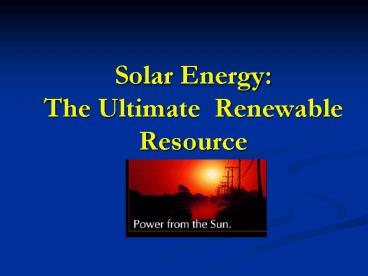Solar Energy: The Ultimate Renewable Resource - PowerPoint PPT Presentation
1 / 16
Title:
Solar Energy: The Ultimate Renewable Resource
Description:
By using solar water heating over gas water heater, a family will save 1200 ... While solar water heating is relatively low in the US, in other parts of the ... – PowerPoint PPT presentation
Number of Views:288
Avg rating:3.0/5.0
Title: Solar Energy: The Ultimate Renewable Resource
1
Solar Energy The Ultimate Renewable Resource
2
Advantages and Disadvantages
- Advantages
- All chemical and radioactive polluting byproducts
of the thermonuclear reactions remain behind on
the sun, while only pure radiant energy reaches
the Earth. - Energy reaching the earth is incredible. By one
calculation, 30 days of sunshine striking the
Earth have the energy equivalent of the total of
all the planets fossil fuels, both used and
unused!
3
Advantages and Disadvantages
- Disadvantages
- Sun does not shine consistently.
- Solar energy is a diffuse source. To harness it,
we must concentrate it into an amount and form
that we can use, such as heat and electricity. - Addressed by approaching the problem through
- 1) collection, 2) conversion, 3) storage.
4
How much solar energy?
The surface receives about 47 of the total solar
energy that reaches the Earth. Only this amount
is usable.
5
Putting Solar Energy to Use Heating Water
- Two methods of heating water passive (no moving
parts) and active (pumps). - In both, a flat-plate collector is used to absorb
the suns energy to heat the water. - The water circulates throughout the closed system
due to convection currents. - Tanks of hot water are used as storage.
6
Heating Water Active System
Active System uses antifreeze so that the liquid
does not freeze if outside temp. drops below
freezing.
7
Heating Water
- Efficiency of solar heating system is always less
than 100 . - By using solar water heating over gas water
heater, a family will save 1200 pounds of
pollution each year. - Market for flat plate collectors grew in 1980s
because of increasing fossil fuels prices and
federal tax credits. But by 1985, when these
credits were removed and fossil fuel prices were
low, the demand for flat plate collectors shrunk
quickly. - While solar water heating is relatively low in
the US, in other parts of the world such as
Cyprus (90) and Israel (65), it proves to be
the predominate form of water heating.
8
Heating Living Spaces
Passive Solar
Trombe Wall
Passively heated home in Colorado
9
Heating Living Spaces
- A passively heated home uses about 60-75 of the
solar energy that hits its walls and windows. - The Center for Renewable Resources estimates that
in almost any climate, a well-designed passive
solar home can reduce energy bills by 75 with an
added construction cost of only 5-10. - Major factor discouraging solar heating is low
energy prices.
10
Power Towers
Power tower in Barstow, California.
11
Solar-Thermal ElectricityPower Towers
- General idea is to collect the light from many
reflectors spread over a large area at one
central point to achieve high temperature. - Capital cost is greater than coal fired power
plant, despite the no cost for fuel, ash
disposal, and stack emissions. - Capital costs are expected to decline as more and
more power towers are built with greater
technological advances. - One way to reduce cost is to use the waste steam
from the turbine for space heating or other
industrial processes.
12
Direct Conversion into Electricity
- Photovoltaic cells are capable of directly
converting sunlight into electricity. - Battery needed as storage
- No moving parts/ do not wear out, but because
they are exposed to the weather, their lifespan
is about 20 years.
13
Photovoltaics
14
Photovoltaics
15
Solar Panels in Use
- Because of their current costs, only rural and
other customers far away from power lines use
solar panels because it is more cost effective
than extending power lines. - Note that utility companies are already
purchasing, installing, and maintaining PV-home
systems (Idaho Power Co.). - Largest solar plant in US, sponsored by the DOE,
served the Sacramento area, producing 2195 MWh of
electric energy, making it cost competitive with
fossil fuel plants.
16
The End































